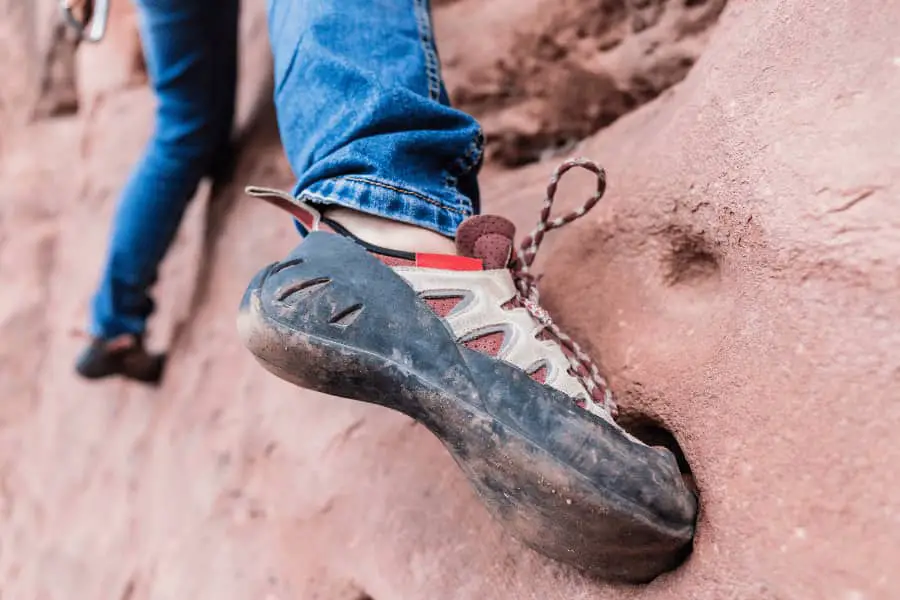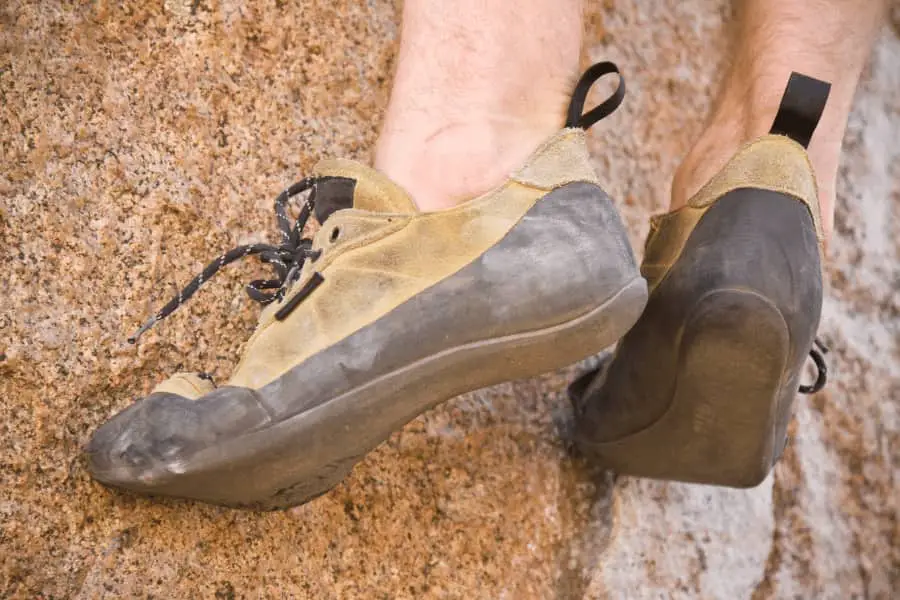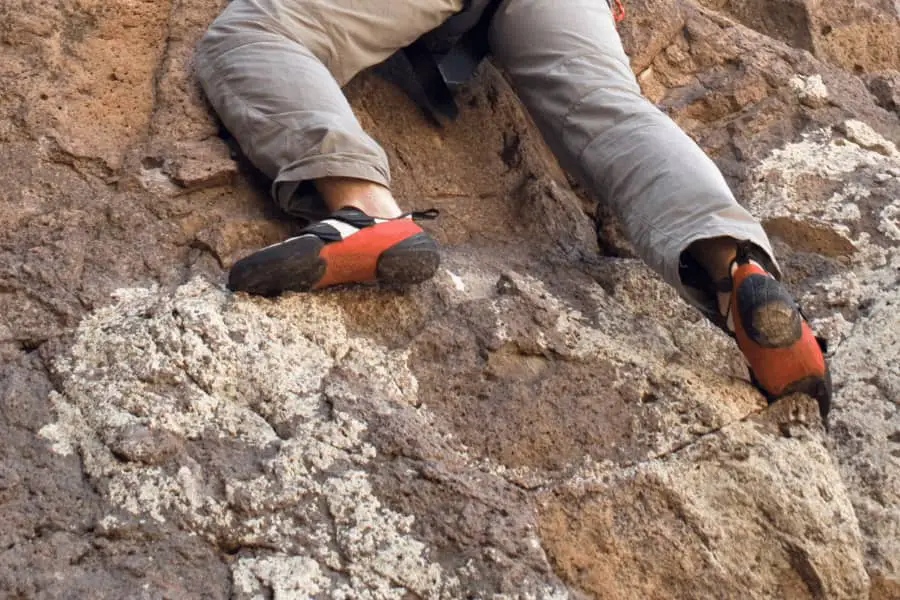
One of my best friends has bunions and said that he has never enjoyed climbing due to the pain caused by the rental shoes. After hearing this, I promptly spent the next two hours of my life researching the best climbing shoes for bunions. Here is what I found out:
The Butora Endeavors are the best beginner climbing shoes for bunions. The best shoes to accommodate bunions are wide asymmetrical shoes with a large toe box and stiff sole. Unlined leather climbing shoes will stretch out over time and allow more space for the bunion(s).
Climbing shoes may as well be bunion’s worst enemy. When picking the best climbing shoe, various factors come into play. If this is done incorrectly, your bunions will cause you a world of pain.
You can see the current price of the Butora Endeavors on Amazon here (affiliate link). By using the affiliate link above or the ones below, you help support the website.
Why Climbing Shoes Aggravate Bunions
Climbing shoes aren’t supposed to feel like your favorite pair of 5 year old stretched out slippers. Climbing shoes are designed to be uncomfortable. For the average foot, this is bearable. But for people with bunions this must feel incredibly painful. I can’t imagine having a tremendously fun time climbing when your feet are in agony every second.
Climbing shoes are designed to push the climber’s toes together in a very tight space. This allows the climber to apply more weight onto smaller areas. Therefore, climbing shoes enhance climber’s abilities to use tiny foot holds and increase friction when climbing.
In short, this presents major problems for people with bunions. This is because bunions force the big toe towards the middle of the foot and make the ball of the foot a lot wider than average. It almost seems as if the person designing climbing shoes thought “All right, how do I make these shoes the worst possible things for people with bunions?”
That being said, all hope is not lost just yet…
Best Climbing Shoe Features For Bunions

The best method to address the aforementioned issues is to wear climbing shoes with the following unique features:
1. Larger shoe width.
Wider shoes allow more foot space than standard shoes. Although climbing shoes are designed to be tight, the additional width will help relieve the inward pressure from the bunion.
2. Larger toe box.
Bigger toe boxes reduce the hotspot on bunions. Although climbing shoes are not known for large toe boxes, some shoes are definitely better than others in this area.
3. Asymmetric design.
Symmetrical shoes provide the most amount of space in the middle of the toe box, near the middle toe. Asymmetrical shoes offset the toe box toward the inside of the foot. This provides more space near the big toe than symmetrical shoes. This offset does not push the big toe toward the middle of the foot as much as symmetrical shoes do.
4. Leather upper shoe material.
Shoe uppers are primarily composed of either leather or synthetic materials. Synthetic materials do not stretch out a lot and will typically maintain their fit overtime. Unlike synthetic shoes, leather shoes stretch over time and will conform better to foot shape.
Shoes with unlined leather uppers are the most pliable type of climbing shoe. Lined leather shoes are designed to reduce stretch overtime and maintain a tighter fit than unlined leather shoes. Therefore, you will want the unlined shoes which allow more stretch in the bunion region.
5. Stiff sole material.
Stiff climbing shoes provide climbers with additional support and comfort compared to softer shoes. Very stiff climbing shoes will not give and are like glueing wooden planks to your feet. This is ideal for bunions as it will provide them with the most protection when climbing.
Climbing shoes with these features will reduce the amount of pressure on the bunion and therefore cause the climber less pain.
Best Available Climbing Shoes For Bunions
After determining what shoe features were the most important for climbing with bunions, I did some digging into which shoes best fit these criteria. The shoes listed below are some of the shoes that stood out the most during my research. I organized them based on climbing ability level and camber (amount of downturn in the shoe).
Best Beginner Climbing Shoe For Bunions
The Butura Endeavor is the best beginner climbing shoe for people with bunions that I have found. These leather asymmetric climbing shoes have a neutral camber (downturn) and are incredibly wide. These shoes will provide beginners with bunions the most comfort and durability they could possibly ask for.
Alternative option: Scarpa Origins. Origins may be the cheapest shoe on this list; however, that does not make them a bad shoe by any means. Origins are an unlined leather shoe with a neutral camber (downturn). They are known for their comfort, support, and durability. In addition, its asymmetric shape provides additional space for the big toe.
Best Intermediate Climbing Shoe For Bunions
The Scarpa Maestro Eco is the best intermediate climbing shoe for people with bunions that I have found. These shoes are one of the most wide and comfortable shoes available with a moderate downturn. Known for their comfort, these asymmetric leather climbing shoes provide the necessary space for bunions while providing the climber with adequate performance.
Alternative option: Five Ten Moccasym. The Five Ten Moccasym are an unlined leather shoe that are perfect for both beginners and intermediates with bunions. Stretching these out overtime will allow for one of the best fits available for people with bunions who desire a moderate camber.
Best Advanced Climbing Shoe For Bunions
The Scarpa Boostic is the best advanced climbing shoe for people with bunions that I have found. These aggressive shoes will provide advanced climbers with the most comfort possible for bunions while maintaining peak performance.
Alternative option: La Sportiva TC Pros. TC Pros are the most expensive shoe listed in this article and it is not without good reason. These shoes are known to have been worn by multiple professional climbers like Alex Honnold, Tommy Caldwell and Nalle Hukkataival. TC Pros are a stiff, asymmetric shoe that will stretch overtime allowing the climber great performance and comfort.
How To Fit Climbing Shoes For Bunions

Traditional climbing shoes are typically supposed to fit as tight as possible to maximize performance. The harsh truth is that with bunions, you will have to sacrifice performance for “comfort”. You will alleviate more pain from you bunions by purchasing more spacious shoes. On the other hand, this will decrease you climbing ability slightly.
Looser shoes will prevent you from generating the same amount of friction and force on smaller foot holds. The key is to find a pair of shoes that are loose enough to not cause you unbearable pain but tight enough to allow you to climb at levels you are proud of.
To do this, I recommend ordering a show size that you can fit into with socks on with only minor discomfort. That way, when you are climbing (without socks on) your bunions will have ample space and won’t cause you as much pain.
Your health and ability to walk should always come before your ability to climb slightly better.
Alternative Options To Accommodate Bunions In Climbing Shoes
If the above shoe option(s) do not work for you, there are other ways to accommodate bunions in climbing shoes.
Locally stretch out unlined leather shoes. I recommend buying leather climbing shoes that are snug but not too uncomfortable and stretching them out before use. To do this, you can purchase a spot shoe stretcher if you do not already own one. Spot shoe stretchers are designed to stretch out specific areas of shoes to allow more room for bunions and hammer toes.
Climb barefoot. Barefoot climbing is generally not allowed at indoor climbing gyms. Indoor gyms consider climbing barefoot to be unhygienic and a safety hazard. That being said, there are incredibly successful barefoot climbers in the world such as Vu Nguyen and Charles Albert. Just try to keep the barefoot climbing outdoors.
Get custom made climbing shoes. This is the most expensive option and can cost you north of $300 easy for a pair of custom shoes. That being said, this option will be your best bet at getting climbing shoes that fit you perfectly and allow you to climb your best. I only recommend this option as a last resort or if you want to climb competitively. Custom made climbing shoes should not be needed for the average leisure climber as at least one of the aforementioned options is likely to work well enough for you.
The bottom line? When purchasing climbing shoes for bunions you should look for wide asymmetric shoes with a large toe box. If you are unable to find a suitable pair of shoes you can either stretch out leather shoes, order custom made shoes, or climb barefoot.
